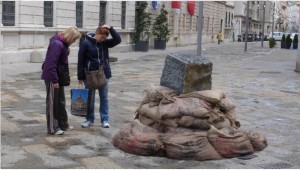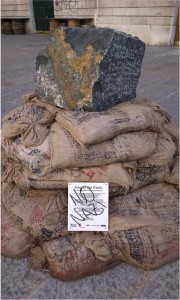
Dear Kate,
I have been thinking a lot in the words of Francesca for our event “Sprachlisches Palimpsest” that framed our second opening for the work here in Graz, it was so interesting to hear about the positioning of the piece as part of the on growing discourse of contemporary art in public space in the city of Trieste.
So many discussions around the work, to see the people standing there while observing the stone makes me smile. It seems that to allocate the piece in such an important passage of the city added a layer of silence. Somehow we’ve introduced a stop signal, a moment for reflection within the normal route of the inhabitants of the place; a quiet and individual dialogue with those visitors.
Francesca collected some of the opinions; it was mesmerizing to hear some of them. The reflections on the trenches of the war, the sacks as contention for water disasters, the natural balance observed, but above all it came to my attention the impressions on the piece as an ode to commercial exchange. The past of the city and identity as a port gives strong force to discourse and makes the Rose of the Winds a mythical anchor.
Now I understand her insistence in the signal; an information table gives a delicate background to the piece. Generally I am very careful with the information around a public interventions, even if we prepared the signals on time, I think they did not arrive on time, because of that fear that always torture me of generating artificial discourses, I am always so afraid of conductism. In this case nevertheless it was ultimately necessary, to establish interaction with the viewer. I wonder if the Anti-Fascist group that left the imprint on the sign did it as a protest against the aesthetic of the empire. Maybe that is the reason they were respectful with the piece, they just damage what the considered authority.
Maybe it would have been better to have all the languages as in Graz…you think multilingualism opens the conceptual layer of the piece? I feel that by having the opportunity to visualize the multiple languages of the project, made the Graz sign a very important extension of the semantic of the piece. Language multiplies sense.
Dear Naya,
You ask me whether we should have put all the languages on the Trieste sign – does multilingualism open the conceptual layer of the piece? I think so of course (multilingualism for me is always a good thing) although I do not know whether it would make any difference to the message-writers.
In Sarajevo we ensured that the multilingual sign was present even during the set-up, and it was interesting to observe how people interacted with the sign itself, with the multilinguality and the information, to look at the piece, back at the sign, and to the piece again. Its startlingly contrasting aesthetic provides a further dimension that is almost a puzzle for the viewer, the instinct is to ask, how are these objects connected?
Sitting outside in the dark of the early evening, waiting for the stone to arrive, I watched as a dog-walker paused, tried to discern the writing on the sign, rummaged through his pockets for a torch and stood for a few minutes, a small pool of light in the dusk, reading and looking, reading and looking.
